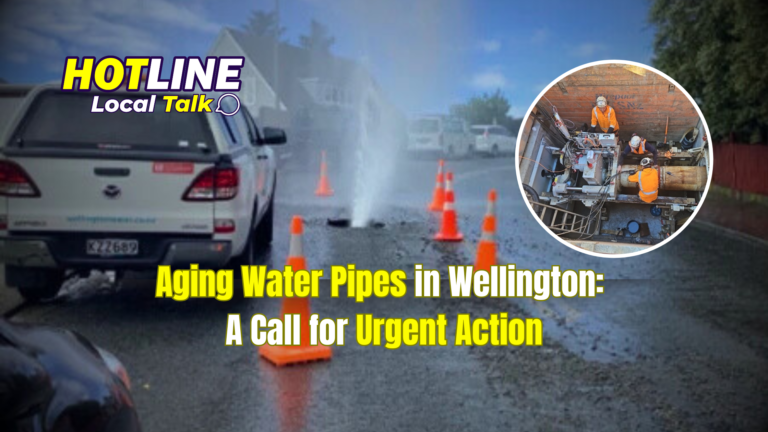Wellington’s aging water infrastructure is under significant strain, with frequent failures highlighting decades of underinvestment. The city is now at a critical juncture, as it grapples with increasing maintenance costs, population growth, and climate-related pressures. Here’s a detailed look at the issue, the areas most affected, and potential solutions.
Suburbs Most Affected: Where the Cracks Are Showing
Some of Wellington’s most populous suburbs, including Karori, Johnsonville, and Miramar, are bearing the brunt of infrastructure decay. These areas have experienced repeated disruptions due to burst pipes and persistent leaks. For instance, Miramar recently faced a weeks-long water leak that went unresolved, spilling millions of litres of treated water onto streets. Meanwhile, Karori has become infamous for sudden water outages caused by aging pipes that fail under pressure.
Picture source: Priority One Leak
Suburbs in the Hutt Valley, including Lower Hutt and Upper Hutt, are also heavily impacted. A significant portion of their water infrastructure dates back to the mid-20th century, with some pipes exceeding 70 years in age. Regular disruptions have inconvenienced residents, disrupted businesses, and put undue strain on the local water authority, Wellington Water.
Why Is Wellington Facing This Crisis?
Aging Infrastructure
Wellington’s water pipes, installed primarily between the 1940s and 1970s, are well past their intended lifespan. Cast iron and asbestos-cement pipes, once standard, are now deteriorating rapidly, leading to cracks, leaks, and bursts.
Population Growth
The city’s population has grown steadily, now exceeding 200,000 in Wellington City and over 420,000 in the wider region. This growth has increased demand on an already overstretched system, leaving little room for maintenance without service disruptions.
Climate Change Impacts
Rising temperatures and irregular rainfall patterns are exacerbating infrastructure stress. Long, dry summers are reducing river and aquifer levels, while heavy rainstorms increase the risk of pipe bursts. These climate-related factors have worsened water supply challenges across the city.
Chronic Underinvestment
Historical underfunding has compounded the problem. Wellington City Council (WCC) has only recently begun to allocate significant funding for infrastructure upgrades, after decades of minimal investment.
The Role of Wellington City Council: Past and Present
In the past, the council’s role in water infrastructure management was largely reactive, focusing on short-term fixes rather than proactive upgrades. However, a series of high-profile failures in recent years has forced a shift in priorities.
Picture source: Wellington.govt.nz
Current Actions by WCC:
Increased Budget: The council’s Long-Term Plan includes a commitment to invest $1.8 billion in water infrastructure over the next decade.
Collaboration with Wellington Water: The council is working closely with Wellington Water to identify critical problem areas and prioritise replacements.
Leak Reduction Campaigns: Initiatives to reduce water loss from leaks aim to save millions of litres of water annually.
Picture source: Wellington.govt.nz
Despite these efforts, critics argue that the council remains too slow in addressing the systemic issues. Wellington Water has warned that maintenance and renewal need to accelerate to prevent further failures and water shortages.
Exploring Solutions
1. Comprehensive Infrastructure Upgrades
The most effective solution involves replacing aging pipes across the city. This is a costly and time-consuming endeavour, but it is critical for long-term sustainability. Modern materials like polyethylene and ductile iron could significantly reduce failures.
2. Enhanced Water Storage
Expanding the capacity of existing reservoirs, such as the Stuart Macaskill Lakes, and building new ones could help buffer against periods of low rainfall and high demand.
3. Community Involvement in Water Conservation
Wellingtonians can play a crucial role by reducing household water consumption. Fixing domestic leaks, installing water-efficient appliances, and adopting rainwater collection systems can collectively reduce demand.
4. Innovative Solutions
Smart Technology: Using sensors to monitor pipe conditions and detect leaks early can prevent major failures.
Greywater Systems: Encouraging the reuse of water from showers and sinks for non-potable purposes could reduce demand on the mains supply.
5. Central Government Assistance
The council may need financial support from the central government to fast-track critical projects. Collaboration on legislative reforms, such as increased powers under the Urban Development Act, could also help address land-related challenges that delay infrastructure projects.
The Way Forward
Wellington faces a daunting task in modernising its water infrastructure, but the city has started to take meaningful steps. Increased funding, improved planning, and greater community engagement are paving the way for a more resilient water system. However, to truly resolve the crisis, long-term commitment and collaboration between the council, government, and residents will be essential.
The costs of inaction are clear: continued disruptions, water shortages, and a loss of public confidence. Now is the time for Wellington to secure its water future, one pipe at a time.
CONTRIBUTE
Have stories, yarns, mad scoops, or community news to share. We often pay for awesome content and life shattering stories. What have you witnessed?


